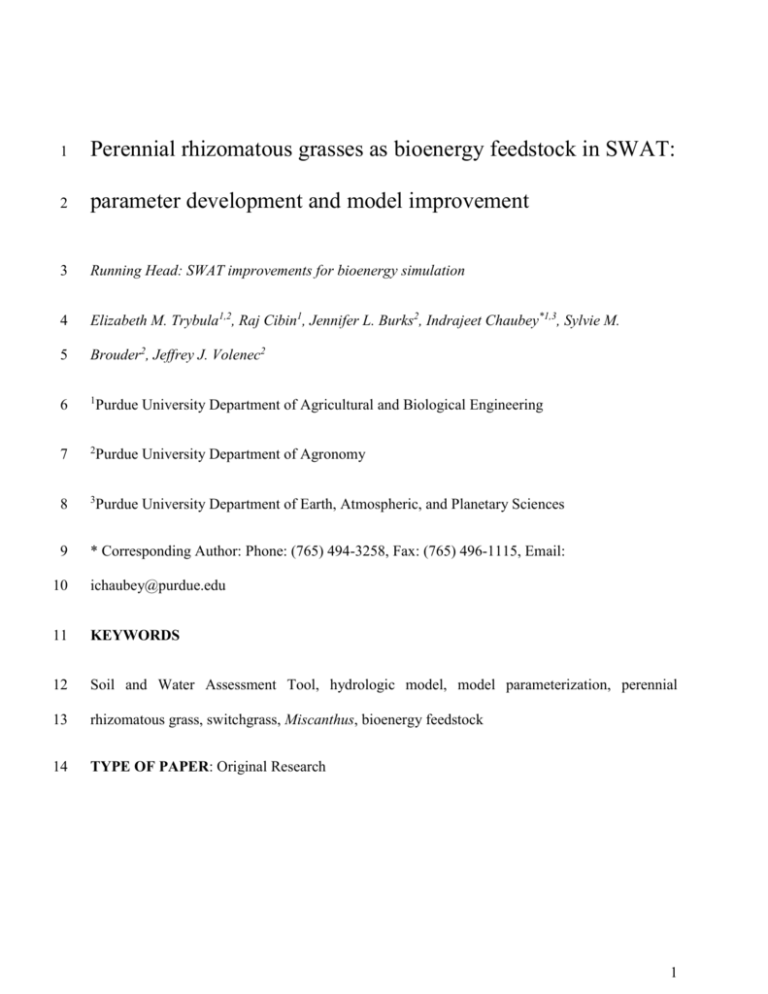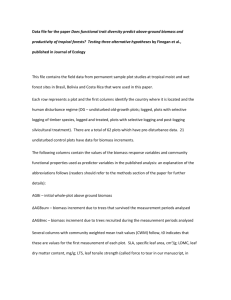gcbb12210-sup-0001-FgiS1-S5-TableS1-S2
advertisement

1 Perennial rhizomatous grasses as bioenergy feedstock in SWAT: 2 parameter development and model improvement 3 Running Head: SWAT improvements for bioenergy simulation 4 Elizabeth M. Trybula1,2, Raj Cibin1, Jennifer L. Burks2, Indrajeet Chaubey*1,3, Sylvie M. 5 Brouder2, Jeffrey J. Volenec2 6 1 Purdue University Department of Agricultural and Biological Engineering 7 2 Purdue University Department of Agronomy 8 3 Purdue University Department of Earth, Atmospheric, and Planetary Sciences 9 * Corresponding Author: Phone: (765) 494-3258, Fax: (765) 496-1115, Email: 10 ichaubey@purdue.edu 11 KEYWORDS 12 Soil and Water Assessment Tool, hydrologic model, model parameterization, perennial 13 rhizomatous grass, switchgrass, Miscanthus, bioenergy feedstock 14 TYPE OF PAPER: Original Research 1 15 SUPPLEMENTAL INFORMATION 16 17 Figure S1. Harvest path (a) and plot quadrat before (b) and after (c) Miscanthus residue 18 collection (2011); 25-35% of plot aboveground biomass remained on the field after harvest for 19 Miscanthus and switchgrass. 20 biomass sample. Harvester yield was 70-95% of hand harvested aboveground 2 b. One Week Moving Average (Emergence Period, Annual Inset) 20 2009 2010 2011 15 10 Annual 30 5 20 0 10 0 -5 60 70 80 90 100 110 Julian Day 100 Base Temperature 8 C 300 20 15 10 Annual 30 5 20 0 10 0 -5 60 70 80 90 100 110 d. -10 120 0 Julian Day 100 200 300 Base Temperature 10 C 2500 2500 2000 2000 1500 1500 1000 1000 500 500 0 0 0 22 200 Two Week Moving Average (Emergence Period, Annual Inset) Heat Units (C) Heat Units (C) c. -10 120 0 Moving Average of Average Daily Air Temperature (C) 21 Moving Average of Average Daily Air Temperature (C) a. 100 200 Julian Day 300 0 100 200 300 Julian Day 23 Figure S2. One- (a) and two-week (b) moving averages during the period of emergence (grey 24 band) for WQFS and central Illinois studies provided reasonable ranges for Midwestern base 25 temperature 8° C (c) and 10° C (d) to estimate corresponding heat units to maturity 26 3 27 28 Figure S3. Leaf area index development curves for observed values (2010 to 2011); whisker 29 boxplots demonstrate first and third quartiles, minimum and maximum values. Dotted line is the 30 mean, solid line is the median. Solid dots values exceed twice the interquartile range 31 4 32 33 34 Figure S4. 35 outputs with SWAT database continuous corn growth values for total biomass production (a), 36 leaf area index (b), total plant nitrogen (c), and total plant phosphorus (d). Comparison of Miscanthus and switchgrass suggested parameter crop growth 5 37 38 Figure S5. Comparison of simulated Miscanthus growth using existing SWAT 2009 code and 39 code changes proposed in this study for total biomass production (a), total plant nitrogen (b), leaf 40 area index (c), nitrogen uptake (d), evapotranspiration (e), and total plant phosphorus (f). 41 Changes in the SWAT model were implemented to better represent physiological characteristics 42 of perennial rhizomatous grasses. 6 43 Table S1. Major and Minor changes to source code in SWAT Type of Change File Code Readplant.f if (blai(ic) >= 13.0) blai(ic) = 13.0 Comment Modified from 10 to 13 Adjusted n-fraction for stover removal= Harvestop.f Deleted root decomposition fractions for PRG Major Root fraction calculation equation changed Grow.f The equation was wrong No nutrient uptake in stress (temp or water or aeration stress)=1 Extended LAI development to have DLAI>1 Nlch.f if (vv > 1.e-10) co = Max(vno3 / vv, 0.) Soil_chem.f sol_orgn(j,i) = 10000. * (sol_cbn(j,i) / 14.) * wt1 Hruyr.f Header.f Sim_inityr.f Minor Harvgrainop.f Killop.f Sim_initday.f Zero0.f subyr.f Virtual.f There was some difference between windows and linux simulation. CN ratio changed back to 14 pdvas(66) = yldanu(j) pdvas(67) = BioYld(j) & "LAI"," YLDt/ha"," BioYLDtha"," GrnYLDtha", & & "LATNO3kg/h","GWNO3kg/ha"," GrainT/ha"," BiomT/ha", & BioYld = 0. GrainYld = 0. GrainYld(j) = GrainYld(j) + yield / 1000. !bio_yrms(j) = bio_yrms(j) + bio_ms(j) / 1000. sub_grain = 0. sub_Biom = 0. sub_grain = 0. sub_Biom = 0. pdvab(19) = sub_grain(sb) pdvab(20) = sub_Biom(sb) sub_grain(sb)= sub_grain(sb) + GrainYld(j) * hru_fr(j) sub_Biom(sb)= sub_Biom(sb) + BioYld(j) * hru_fr(j) Commented it accounts biomass twice in harvest and kill. - this can affect the kill only operation Initialization sub_grain and sub_biom added to output subbasin level yields 44 7 45 Table S2. Relative sensitivity of model outputs to crop growth parameters, ranked by greatest 46 sensitivity of harvested biomass yield. 47 approach zero. Parameter Parameter Definition1 BIO_E Decreased sensitivity indicated as absolute values Harvested Biomass Yield Water Yield Nitrate Total Load Phosphorus Load Radiation Use Efficiency in ambient CO2 0.908 0.252 -1.076 0.502 T_BASE Base Temperature 0.269 -0.533 -1.435 -0.167 T_OPT Optimal Temperature -0.256 0.016 0.593 -0.072 EXT_COEF Light Extinction Coefficient 0.133 0.042 -0.281 0.072 BLAI Maximum Leaf Area Index (LAI) 0.131 -0.279 -0.468 -0.096 DLAI Point in growing season when LAI declines 0.098 -1.161 -1.482 -0.574 FRGRW1 Fraction of growing season coinciding with LAIMX1 -0.089 0.169 0.257 0.048 LAIMX2 Fraction of BLAI corresponding to second point on optimal leaf area development curve 0.076 -0.106 0.234 0.048 FRGRW2 Fraction of growing season coinciding with LAIMX2 -0.066 0.093 0.203 0.048 LAIMX1 Fraction of BLAI corresponding to first point on optimal leaf area development curve 0.061 -0.114 -0.172 -0.048 CNYLD Plant nitrogen fraction in harvested biomass -0.052 -0.013 -1.342 -0.024 PLTNFR3 Plant nitrogen fraction at maturity (whole plant) -0.033 -0.01 0.422 -0.023 GSI Maximum stomatal conductance 0.002 -0.296 -0.148 -0.167 PLTNFR1 Plant nitrogen fraction at emergence (whole plant) 0.002 0.001 -0.148 0 0.001 0 0.46 0 PLTNFR2 Plant nitrogen fraction at 50% 8 maturity (whole plant) CHTMX Maximum Canopy Height 0 0.019 0 0 FRGMAX Fraction of GSI corresponding to the second point on the stomatal conductance curve 0 -0.016 0.008 0 VPDFR Vapor pressure deficit 0 0.007 -0.008 0 RSDCO_PL Plant residue decomposition coefficient 0 0 0.008 0 PLTPFR3 Plant phosphorus fraction at maturity (whole plant) 0 0 0 0.323 CPYLD Plant phosphorus fraction in harvested biomass 0 0 0 0.163 USLE_C Minimum Crop Factor for Water Erosion 0 0 0 0.072 RDMX Maximum Rooting Depth 0 0 0 0 PLTPFR1 Plant phosphorus fraction at emergence (whole plant) 0 0 0 0 PLTPFR2 Plant phosphorus fraction at 50% maturity (whole plant) 0 0 0 0 48 49 9 50 51 52 Short Summary of Key Parameters for Crop Growth in SWAT 53 development, seasonal leaf area development, and plant nutrient uptake. Once optimal growth 54 values are established, site-specific conditions limiting crop growth are simulated in SWAT via 55 water, nutrient and temperature stress attributed to soil type, nutrient availability and weather 56 characteristics. 57 temperature inputs. Daily heat units (HU) accumulate throughout the growing season, serving as 58 an inherent scheduling component of day-to-day biomass production and leaf area development 59 to crop maturity. A crop-specific base air temperature (T_BASE) serves as proxy for necessary 60 soil moisture-temperature characteristics to trigger initiation of seasonal regrowth. 61 biomass accumulation is a direct function of intercepted photosynthetically active radiation 62 (PAR) and crop-specific radiation use efficiency (RUE, listed as BIO_E). 63 determines the amount of intercepted radiation, and leaf area development is modeled using an 64 optimal leaf area development curve. The curve shape and bounds are defined in the model 65 using six parameters calculated from measured leaf area index (LAI). Daily nutrient uptake is 66 simulated by the model as a function of the plant nutrient demand and soil nutrient availability. 67 The daily nutrient demand is a function of biomass developed to date and nutrient requirements. 68 Nutrient requirements are characterized at three growth stages (emergence, development, and 69 maturity), represented by nutrient fraction parameters for nitrogen (PLTNFR) and phosphorus 70 (PLTPFR). Crop yield output is a function of biomass, harvest index (HI), and harvest efficiency 71 (HEFF). Optimal crop growth in the SWAT model is driven by three key elements: biomass Simulated plant growth is initiated and regulated by average daily air Daily Plant leaf area 72 10








